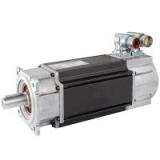Cables
Cables are an important part of a servo
system installation. Not only must the noise
immunity and integrity of the cabling and
connectors be correct, but also SAFETY and EMC
regulations must be complied with to ensure
successful, reliable and fail safe operation.
One of the most frequent problems experienced by
motion systems engineers is incorrect
connections of the motor to the drive.
Control Techniques ready made cables mean
system installers can avoid the intricate, time
consuming assembly normally associated with
connecting servo systems. Installation and
set-up time are greatly reduced - there is no
fiddling with wire connections and crimp tools,
and no fault finding.
The cables are available in lengths from 3m
to 50m/100m (custom lengths available).
Cable range for motor-drive
combination
Power cable variants
Phase conductors 1.0mm² (10A) to 16mm²
(70A)
With and without brake wire pairs
Motor end connector
Motor end Ferrules for Hybrid box
Drive end is tailored to suit the drive
and can be Ferrules or Ring terminals
Cable features
For dynamic performance PUR outer sheath
for oil resistance and dynamic performance.
The PUR jacket has excellent abrasion,
chemical and ozone resistance, low smoke,
low halogen flame retardant construction
suitable for internal and external
industrial environments.
Complies with DESINA coding - Orange for
power, Green for signal
Power cable and plugs UL recognized
Optimum noise immunity
Encoder cable has low volt drop for long
cable lengths and separately screened
thermistor wires.
No need for crimp and insertion /
removal tools
Production build gives quality and price
benefits
Braided screen for greater flexibility
and wear
Power cables with and without brake
wires
Cable assembly type identification label
Brake wires are separately shielded
within the power cable
Fan Box (field fitted)
Available for 075 to 190.
One fan box per frame size.
Easy assembly onto fm motors using two
screws per side fitting into existing
Unimotor fm housing slots.
Fan blown models available with higher
performance (E5/U5 models).
Feedback
Resolver
A passive wound device consisting of a stator
and rotor elements excited from an external
source, such as an SM-Resolver, the resolver
produces two output signals that correspond to
the sine and cosine angle of the motor shaft.
This is a robust absolute device of low
accuracy, capable of withstanding high
temperature and high levels of vibration.
Positional information is absolute within one
turn - i.e. position is not lost when the drive
is powered down.
Incremental Encoder
An
electronic device using an optical disc. The
position is determined by counting steps or
pulses. Two sequences of pulses in quadrature
are used so the direction sensing may be
determined and 4 x (pulses per rev) may be used
for resolution in the drive. A marker pulse
occurs once per revolution and is used to zero
the position count. The encoder also provides
commutation signals, which are required to
determine the absolute position during the motor
phasing test. This device is available in 4096,
2048 and 1024 ppr version. Positional
information is non absolute - i.e. position is
lost when the drive is powered down.
SinCos/Absolute Encoders
Types available are: Optical or Inductive -
which can be single or multi-turn.
Optical: An electronic
device using an optical disc. An absolute
encoder with high resolution that employs a
combination of absolute information,
transmitted via a serial link, and
sine/cosine signals with incremental
techniques.
Inductive: An
electronic device using inductively coupled
PCB’s. An absolute encoder with medium
resolution that employs a combination of
absolute information, transmitted via a
serial link, and sine/cosine signals with
incremental techniques. This encoder can be
operated with the drive using either
sine/cosine or absolute (serial) values
only. Positional information is absolute
within 4096 turns - i.e. position is not
lost when the drive is powered down. Due to
the bearingless encoder design, we recommend
the inductive encoder for light duty
applications only.
Multi-turn
As previous but with extra gear wheels included
so that the output is unique for each shaft
position and the encoder has the additional
ability to count complete turns of the motor
shaft up to 4096 revolutions.
Electronic name plating
Available on both these types of encoders,
and allows quick set-up times as the motor
information is stored on board the encoder
(075-250 motor only).


![]() 1.4 to 136Nm
1.4 to 136Nm